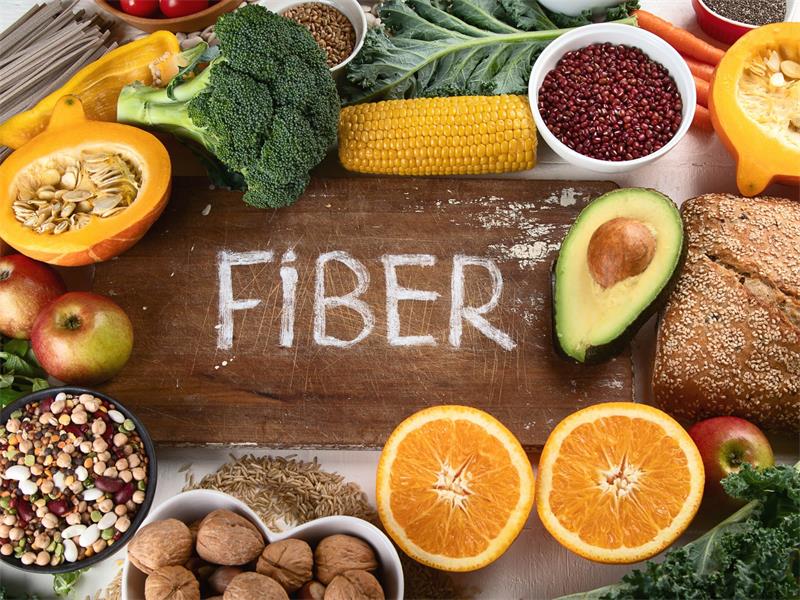Contents
- 1 The Importance of a Healthy Digestive System and Maintaining a Healthy Weight
- 2 The Role of Fiber in Achieving These Goals
- 3 What is Fiber?
- 4 The Digestive Power of Fiber
- 5 The Fiber-Weight Management Connection
- 6 The Science Behind Fiber’s Effects on Hunger
- 7 Beyond Just Weight Management
- 8 Other Health Benefits of Fiber
- 9 Tips for Increasing Daily Intake of Fiber
- 10 Recommended Daily Intake Guidelines
- 11 Conclusion
The Importance of a Healthy Digestive System and Maintaining a Healthy Weight
Our bodies are incredibly complex systems that require proper care and attention in order to function at their best. Two key aspects of overall health are digestion and weight management.
Digestion is the process by which our bodies break down food into nutrients that can be absorbed and used for energy, while weight management involves maintaining healthy body weight through a balance of diet and exercise. Both are critical components of overall health, and both can be impacted by diet.
When our digestive system is not functioning properly, we may experience discomfort, bloating, constipation, or other issues that can affect our quality of life. Similarly, weight management is important because being overweight or obese increases the risk for a variety of health problems including heart disease, diabetes, certain cancers and more.
The Role of Fiber in Achieving These Goals
Fiber plays an essential role in both digestion and weight management. Fiber is the part of plant-based foods that our bodies cannot digest or absorb.
There are two main types of fiber: soluble fiber which dissolves in water to form a gel-like substance that helps regulate blood sugar levels; and insoluble fiber which does not dissolve in water but rather adds bulk to stool to promote regularity. Fiber has many benefits for digestion including promoting regular bowel movements, preventing constipation by bulking up stool consistency, and reducing inflammation in the digestive system.
In addition to its impact on digestion, fiber also plays an important role in maintaining a healthy weight. This is because fiber helps us feel full longer after eating since it takes longer for our bodies to digest than other foods without it.
Maintaining good digestive health and managing one’s weight are essential parts of achieving overall wellness. Fortunately incorporating more fiber-rich foods into your diet can help with both!
What is Fiber?
Fiber is a type of carbohydrate that your body cannot digest. Instead, it passes mostly intact through the digestive system. While it may not be digested, fiber plays an important role in maintaining a healthy digestive system and promoting overall health.
Types of Fiber
There are two types of fiber: soluble fiber and insoluble fiber. Soluble fiber dissolves in water and forms a gel-like substance within the digestive tract. Insoluble fiber, on the other hand, does not dissolve in water and adds bulk to stool.
Soluble fiber can be found in foods such as oats, beans, apples, and carrots. This type of fiber is beneficial because it can help lower cholesterol levels, regulate blood sugar levels, and promote healthy bowel movements.
Insoluble fiber is found in foods such as wheat bran, nuts, cauliflower, and green beans. This type of fiber helps prevent constipation by adding bulk to stool and speeding up its passage through the digestive tract.
Sources of Fiber
To get enough dietary fiber from your diet, you should aim to consume a variety of fruits, vegetables, whole grains, legumes, or beans daily. Fruits such as apples with skin on them are high in soluble fibers while strawberries contain more insoluble fibers.
Vegetables like broccoli or spinach also contain both types of fibers which make them excellent choices for those looking to increase their daily intake. Whole grains are another great source of dietary fibers with barley being one of the best examples of how much one grain can offer both types: insoluble fibers from its bran layer and soluble ones from its endosperm layer.
Legumes or beans like lentils or chickpeas are also very high in fiber – up to 16 grams per cup cooked – which makes them perfect for vegans or vegetarians looking for alternative sources of protein. Overall, consuming a diet rich in fruits, vegetables, whole grains and legumes can help you get the fiber that your body needs for optimal health.
The Digestive Power of Fiber
Fiber is an essential nutrient that plays a crucial role in overall health, particularly when it comes to digestion and weight management. But how exactly does fiber work its magic in our digestive system?
Soluble vs. Insoluble FiberFirst, it’s important to understand the two types of fiber: soluble and insoluble. Soluble fiber dissolves in water and becomes a gel-like substance as it passes through the digestive tract. This type of fiber can be found in foods such as oats, beans, apples, and carrots. Insoluble fiber doesn’t dissolve in water and instead passes through our digestive system largely intact. Found in foods such as whole grains, nuts, seeds, and many vegetables, insoluble fiber helps to bulk up stool and promote regular bowel movements.
Benefits for Regularity
Both types of fiber play a critical role in maintaining regularity by keeping the digestive system moving smoothly. Soluble fibers absorb water to become soft and sticky which can help slow down digestion allowing for more nutrient absorption while also promoting softer stool which makes it easier to pass without straining or causing constipation. Insoluble fibers add bulk by absorbing water but do not dissolve which makes them perfect for stimulating bowel movements while cleaning out waste along the GI tract.
Consuming enough dietary fiber on a regular basis will help keep your bowels working properly thereby significantly reducing your risk of developing gastrointestinal issues like irritable bowel syndrome (IBS) or Crohn’s disease over time. If you’re looking to boost your intake of both types of dietary Fiber then consider adding some high-fiber options into your daily routine like chia seeds or flaxseeds on top of smoothie bowls or yogurt with fruit like blueberries or raspberries added for an extra dose – making weight loss goals achievable!
The Fiber-Weight Management Connection
Have you ever felt like no matter what you eat, you just can’t seem to get full? This is where fiber comes in. Unlike other macronutrients like protein and fat, fiber is not absorbed by the body.
Instead, it passes through the digestive system largely intact and can aid in weight management by promoting satiety and reducing hunger cravings. As fiber moves through the digestive system, it absorbs water and expands in the stomach, creating a feeling of fullness that can last for hours.
This helps decrease overall calorie intake without leaving you feeling deprived or hungry. In fact, studies have shown that people who consume high-fiber diets tend to eat fewer calories throughout the day compared to those with low-fiber diets.
But how much of an impact does fiber really have on weight loss? A study published in the Annals of Internal Medicine found that people who followed a high-fiber diet lost significantly more weight than those who followed a lower-fiber diet.
The high-fiber group also showed improvements in blood sugar levels, cholesterol levels, and blood pressure compared to the low-fiber group. So if you’re looking to lose weight or maintain a healthy weight, adding more fiber-rich foods into your diet may be a simple yet effective strategy.
The Science Behind Fiber’s Effects on Hunger
Ever wonder why some foods seem to keep you full longer than others? The answer lies in their macronutrient composition, specifically their fiber content.
As mentioned earlier, fiber has unique properties that can help reduce hunger cravings and promote satiety. One way this works is through delayed gastric emptying.
When we eat food without much fiber content like processed snacks or sugary drinks our stomach empties quickly causing us to feel hungry sooner than later. With higher amounts of soluble fibers present in our food such as beans or legumes, we are able to slow down the process of gastric emptying which helps keep us satisfied for a longer period of time.
Another way fiber can help reduce hunger cravings is by interacting with gut hormones that regulate appetite. The hormone ghrelin, for example, stimulates hunger and increases after fasting or calorie restriction.
Fiber can reduce levels of ghrelin in the blood, decreasing feelings of hunger and promoting fullness. In addition, fiber-rich foods tend to take longer to chew and eat than processed foods or fast food meals which gives our brain time to receive “fullness cues” from the digestive system signaling that we’ve had enough food.
Beyond Just Weight Management
While weight management is a common reason people choose to increase their fiber intake, there are numerous other health benefits associated with consuming enough fiber. For example, soluble fibers like those found in oats or barley have been shown to lower cholesterol levels by binding with bile acids in the gut and eliminating them through feces. Fiber is also helpful for regulating blood sugar levels as it slows the absorption of carbohydrates in the small intestine lowering glucose spikes.
On top of these benefits, studies have shown that individuals who consume high amounts of dietary fiber have a lower risk for developing chronic conditions such as heart disease and certain types of cancer. So if you need another reason to increase your daily intake consider this: more than one study has suggested that increased consumption helps improve gut health overall leading to better digestion and immune function.
Other Health Benefits of Fiber
Lowering Cholesterol Levels
Did you know that consuming enough fiber can help lower cholesterol levels? Soluble fiber, in particular, has been shown to be effective in lowering LDL (bad) cholesterol levels. This type of fiber binds with cholesterol and bile acids in the gut, preventing them from being absorbed into the bloodstream.
As a result, the liver is forced to produce more bile acids by using up excess cholesterol from the blood. This process ultimately results in lower overall cholesterol levels and reduces the risk of heart disease.
Regulating Blood Sugar Levels
For those with diabetes or those at risk for developing it, fiber is an important nutrient to incorporate into their diet. Soluble fiber slows down digestion and helps regulate blood sugar levels by preventing spikes and crashes throughout the day. When carbohydrates are consumed, they are broken down into glucose (sugar) which enters the bloodstream.
Fiber slows down this process by binding with glucose and delaying its absorption into the bloodstream. This results in a slower rise in blood sugar levels after meals.
Reducing Risk for Certain Diseases
Consuming enough fiber has also been linked to reducing the risk for certain diseases such as heart disease, diabetes, and some cancers. The high-fiber content of fruits, vegetables, and whole grains can reduce inflammation within the body which is associated with an increased risk for these diseases. Additionally, soluble fiber has been shown to reduce triglyceride levels which are important for overall heart health.
Incorporating enough dietary fiber into one’s daily diet can have numerous health benefits beyond digestion and weight management alone. By ensuring proper intake of soluble and insoluble fibers through various food sources such as fruits, vegetables, and whole grains – individuals can improve their overall health and decrease their risk for numerous diseases including heart disease and diabetes while also promoting regular bowel movements and weight management.
Tips for Increasing Daily Intake of Fiber
Now that we know the importance of fiber in our diet, let’s explore some simple ways to increase our daily intake. Here are some tips:
Incorporate Fruits and Vegetables
Fruits and vegetables are a great source of fiber. Aim for at least 5 servings of fruits and vegetables daily.
You can add them to your meals in many ways such as:
- Adding veggies to your omelet or scrambled eggs in the morning
- Having a fruit salad or smoothie as a snack or dessert
- Adding veggies into soups, stews, stir-fries, or casseroles
- Eating raw vegetable sticks with hummus as a snack
Choose Whole Grains Over Refined Grains
When choosing grains such as bread, rice, pasta, and crackers, make sure they are whole grains instead of refined grains. Whole grains have more fiber because they include the bran and germ parts of the grain.
Look for labels that say “100% whole wheat” or “100% whole grain.” Here are some examples:
- Eating oatmeal or other hot cereals with fruit toppings for breakfast
- Making sandwiches with whole-grain bread instead of white bread
- Cooking brown rice instead of white rice
- Eating popcorn (air-popped) instead of chips as a snack
Recommended Daily Intake Guidelines
The amount of fiber you need each day varies depending on age and gender. According to the Academy of Nutrition and Dietetics:
- Males: age 14-50 years: 38 grams/day, age 51 years and older: 30 grams/day
- Females: age 14-50 years: 25 grams/day, age 51 years and older: 21 grams/day
It’s important to gradually increase your fiber intake to avoid digestive discomfort. Also, remember to drink plenty of fluids as fiber absorbs water and helps soften stool.
Incorporating more fiber into your diet can have numerous health benefits such as aiding digestion and weight management. With these tips and recommended daily guidelines in mind, you can make small changes towards a healthier lifestyle.
Conclusion
Recap on the importance of incorporating enough dietary fiber into one’s diet
It is clear that fiber plays a significant role in maintaining a healthy digestive system and achieving sustainable weight loss. By consuming adequate amounts of both soluble and insoluble fibers, we can help regulate bowel movements, reduce hunger cravings, and prevent chronic diseases such as heart disease and diabetes.
Fiber also offers other health benefits such as lowering cholesterol levels and regulating blood sugar levels. It is essential to aim for a balanced diet filled with fruits, vegetables, whole grains, nuts, seeds, and legumes to ensure adequate fiber intake.
Encouragement to make small changes towards a healthier lifestyle
Incorporating more fiber-rich foods into your diet doesn’t have to be challenging or overwhelming. Start by making small changes such as swapping white rice for brown rice, adding a serving of fruit or vegetables to your meals or snacks daily, choosing whole-grain bread over white bread or oatmeal instead of sugary cereals for breakfast. It’s important to remember that healthy eating habits take time and effort but can be very rewarding in the long run.
Making small changes over time will lead to lasting habits that can positively affect your overall health and well-being. Let’s take control of our health by incorporating more high-fiber foods into our diets today!












